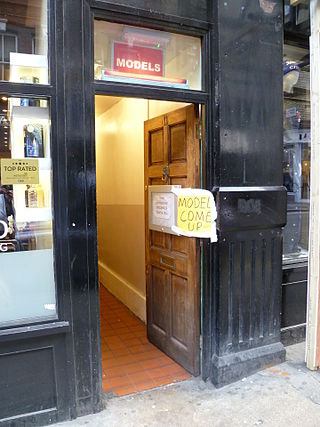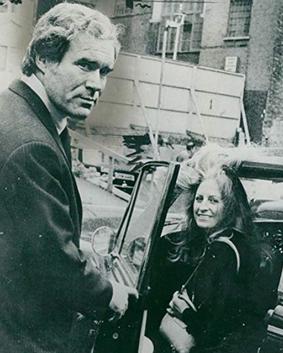
Operation Spanner was a police investigation into same-sex male sadomasochism across the United Kingdom in the late 1980s. The investigation, led by the Obscene Publications Squad of the Metropolitan Police, began in 1987 and ran for three years, during which approximately 100 gay and bisexual men were questioned by police.
Sin City is a nickname that may be applied to an urban area that caters to various vices. These vices may be legal or illegal activities which are tolerated.

Baltimore's The Block is a stretch on the 400 block of East Baltimore Street in Baltimore, Maryland, containing several strip clubs, sex shops, and other adult entertainment merchants. During the 19th century, Baltimore was filled with brothels, and in the first half of the 20th century, it was famous for its burlesque houses. It was a noted starting point and stop-over for many noted burlesque dancers, including the likes of Blaze Starr.

The Toronto Police Service (TPS) is a municipal police force in Toronto, Ontario, Canada, and the primary agency responsible for providing law enforcement and policing services in Toronto. Established in 1834, it was the first local police service created in North America and is one of the oldest police services in the English-speaking world.
The Specialist, Organised & Economic Crime Command is a unit within the Gangs and Organised Crime group of Specialist Crime & Operations within London's Metropolitan Police Service. The unit's main responsibility is to both investigate and take steps to prevent fraud, along with a wide range of other fraudulent crimes which require specialist knowledge and training to investigate. The unit was previously known as the Fraud Squad, or by its previous Specialist Operations designation, SO6.

The Tampa Police Department (TPD) is the primary law enforcement agency for the city of Tampa, Florida. The Tampa Police Department has 985 authorized sworn law enforcement personnel positions and more than 350 civilian and support staff personnel positions. The current police chief is Lee Bercaw.

Sir Robert Mark was a senior British police officer who served as Chief Constable of Leicester City Police, and later as Commissioner of the Metropolitan Police from 1972 to 1977.

The GardaNational Bureau of Criminal Investigation (GNBCI) - formerly known as the Central Detective Unit (CDU) - is the main national criminal investigative branch of the Garda Síochána, the national police force of Ireland.
The New Jersey Transit Police Department (NJTPD) is a transit police agency of the New Jersey Transit Corporation in the state of New Jersey. As provided by NJS Title 27:25-15.1, New Jersey Transit Police Officers have "general authority, without limitation, to exercise police powers and duties, as provided by law for police officers and law enforcement officers, in all criminal and traffic matters at all times throughout the State and, in addition, to enforce such rules and regulations as the NJ Transit Corporation shall adopt and deem appropriate."
The Paedophile Unit is a branch of the Metropolitan Police Service's Child Abuse Investigation Command, based at Scotland Yard in London, England. It operates against the manufacture and distribution of child pornography, online child grooming, and "predatory paedophiles online", and organised crime associated with these.

The Metropolitan Police of Greater London, England is organised into five main directorates, each headed by an Assistant Commissioner, and four civilian-staffed support departments previously under the umbrella of Met Headquarters, each headed by a Chief Officer, the equivalent civilian grade to Assistant Commissioner. Each business groups or directorate has differing responsibilities. The commands are Frontline Policing, Met Operations, Specialist Operations and Professionalism.

The Policing and Crime Act 2009 is an act of the Parliament of the United Kingdom. The Act makes provision about police reform, prostitution, sex offenders, sex establishments and certain other premises. It amends the law on aviation security, misuse, proceeds of crime, extradition and gang related violence.
The Organized Crime Control Bureau (OCCB) was one of the ten bureaus that formed the New York Police Department. The Bureau was charged with the investigation and prevention of organized crime within New York City. The OCCB was disbanded in March 2016 with all investigative entities moved to the Chief of Detectives' office. The reason for this was the NYPD launching a major reshuffle of its investigative forces, consolidating several of them in an effort to tackle the city's biggest crime problem — violence by gangs and youth crews.
Bernard Silver was an English criminal, who was a leading crime boss in the London underworld of the 1950s to 1970s. Active in prostitution, pornography and racketeering, Silver was described as "a working-class East Ender with a taste for fine restaurants and flashy clothes."
The Human Exploitation and Organised Crime Command (SCD9) is a branch of the Specialist Crime Directorate within London's Metropolitan Police Service. The SCD9 is primarily tasked with investigating human trafficking, and also has responsibility for policing prostitution, obscene publications, nightclubs, vice, casino fraud, money laundering and identity fraud.
Controlling Vice: Regulating Brothel Prostitution in St. Paul, 1865–1883 is a book by Minnesotan author Joel Best, published in 1998. It is the fourth book in the History of Crime and Criminal Justice Series, and documents the strategies that the Minnesota police officers enforced in attempts to regulate prostitution in the late nineteenth century.

A Soho walk-up is a flat in Soho, London, United Kingdom, that is used by a female sex worker for the purposes of prostitution. The flats are located on the upper floors of buildings in Soho's red light district, often above shops, and accessed by a staircase from a door on the street. They form a distinctive way of working that is characteristic of the sex industry in Soho, originating in the 1960s and declining during the 21st century.
The Brigade de répression du proxénétisme (BRP) is a judicial police service of the French National Police, responsible for the surveillance of prostitution and the repression of procuring.

James William Humphreys was an English businessman and criminal who owned a chain of adult book shops and strip clubs in London in the 1960s and 1970s. He was able to run his business through the payment of large bribes to serving police officers, particularly those from the Obscene Publications Branch (OPB) of the Metropolitan Police. His diaries—which detailed meetings he had held with police officers, the venues of the meetings and the amounts of bribes paid—provided evidence for the investigation by anti-corruption officers of the Metropolitan Police.

The Violence Suppression Unit (VSU) is a type of unit of the Frontline Policing Directorate, formerly known as Territorial Policing, which is part of London's Metropolitan Police Service (MPS). Its role is to combat street crime, violence, and knife offences, as well as track down high-harm fugitives.










